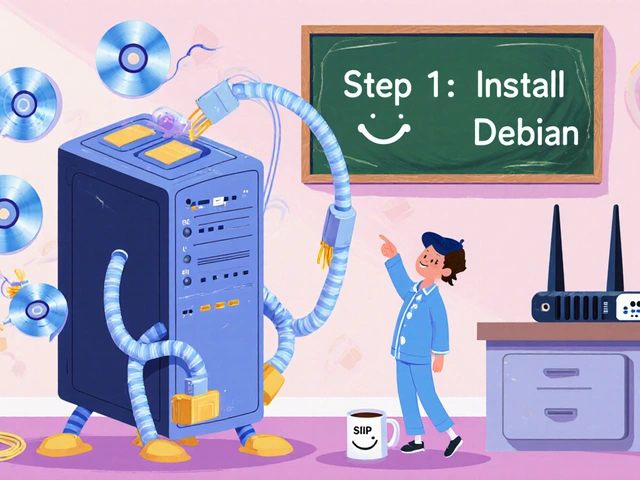Why Mobile VoIP Is No Longer Optional for Remote Teams
Imagine a sales rep stuck in traffic, needing to call a client right now. Or a field technician in a rural area who needs to check in with the warehouse. Or a manager on a flight who has to approve an urgent invoice. If your team relies on landlines or company phones tied to an office desk, these moments become bottlenecks. Mobile VoIP fixes that.
Mobile VoIP lets employees use their smartphones to make and receive business calls over the internet. No desk phone. No office Wi-Fi. Just a phone, an app, and any internet connection-cellular, home Wi-Fi, even airport hotspots. It’s not science fiction. It’s what 68% of businesses now require for their teams to stay connected.
Companies that switched to mobile VoIP saw a 42% drop in communication costs compared to traditional mobile plans. Productivity jumped by 74%. Why? Because people aren’t chained to a location. They can work from anywhere and still sound professional, reachable, and reliable.
What You Need Before You Start
Setting up mobile VoIP isn’t just downloading an app. It’s about preparing your network, choosing the right tools, and understanding what your team actually needs.
- Internet speed: Each call needs at least 3-5 Mbps upload and download. Most 4G networks deliver 15-50 Mbps, which is plenty. But if your employee is on a crowded public Wi-Fi network, that’s a different story. Test the connection before relying on it.
- Network stability: Latency should stay under 150ms. Jitter under 30ms. Packet loss under 1%. If calls sound robotic or cut out, these numbers are your culprit.
- Device compatibility: Your team needs smartphones running iOS 14+ or Android 10+. Older devices may struggle with newer apps or encryption standards.
- Security: All calls should use SRTP (for audio) and TLS 1.2+ (for signaling). If your provider doesn’t encrypt end-to-end, walk away. 43% of mobile VoIP breaches in 2023 came from unsecured public Wi-Fi.
Don’t skip the network check. A bad router or unconfigured QoS (Quality of Service) will make even the best VoIP system sound like a bad phone line.
Choosing the Right Mobile VoIP Provider
Not all VoIP services are built the same. Some are made for call centers. Others are made for field teams. Here’s what actually matters for remote workers:
| Provider | Price per User/Month | Mobile App Quality | Call Handoff (Mobile to Desktop) | Offline Call Queuing | Best For |
|---|---|---|---|---|---|
| RingCentral | $15-$30 | Excellent | Yes | Yes | Teams needing reliability and CRM integration |
| Zoom Phone | $10-$20 | Good | Yes | No | Companies already using Zoom |
| Microsoft Teams Phone | $10-$25 | Very Good | Yes | Yes | Office 365 users |
| Telzio | $10 | Basic | No | No | Small teams on a budget |
| Nextiva | $15-$30 | Very Good | Yes | Yes | Customer service teams |
RingCentral leads in market share with 28% of remote teams using it. Why? It handles call handoffs smoothly and keeps calls queued if the internet drops. Telzio is the cheapest, but it doesn’t support switching between devices mid-call. If your team moves between phone and laptop, handoff matters.
WebRTC is now used in 85% of new mobile VoIP setups. That means users can make calls directly from a browser-no app needed. Useful for quick check-ins, but not for full-time use.

How to Set Up Mobile VoIP in 4 Steps
Follow this sequence. Skip steps, and you’ll end up with frustrated users and dropped calls.
- Start with a pilot: Pick one department-sales, field techs, or customer service. Give 5-10 people the app. Test it for 3-5 days. Do calls drop on the highway? Does the app drain the battery? Fix issues here before rolling out company-wide.
- Choose your users and assign numbers: Add each person to your VoIP system. Assign them a business number (not their personal cell). Most systems auto-provision phones-just install the app, log in, and it configures itself.
- Set up call routing: Create rules. Should incoming calls ring their phone, desktop, and tablet at the same time? Should calls go to voicemail after 3 rings? Should after-hours calls route to an answering service? These settings prevent missed calls.
- Train your team: A 45-minute session is enough. Show them how to: transfer calls, check voicemail from the app, use call hold, and switch between Wi-Fi and cellular without dropping the call. Most people don’t know these features exist.
One company with 85 sales reps used Telzio. Setup took under two hours total thanks to auto-provisioning. But they had to configure QoS on their cellular data plans to prevent drops during commutes. That’s the kind of detail you can’t skip.
Common Problems and How to Fix Them
Mobile VoIP works great-until it doesn’t. Here’s what goes wrong and how to fix it.
- Battery drain: VoIP apps can use 15-20% battery per hour. Newer apps with Opus codec cut that by 25%. Tell users to turn off background app refresh for the VoIP app. Disable video calling unless needed.
- Call drops on weak networks: 57% of issues come from bad public Wi-Fi or spotty cellular. Recommend users avoid coffee shop Wi-Fi for critical calls. Enable Wi-Fi calling on their phones (if carrier supports it). Use a mobile hotspot as backup.
- Feature gaps: Mobile apps often lack desktop features. Only 65% of providers offer seamless handoff. Only 41% support simultaneous ring without extra setup. Check this before buying.
- Security on public networks: Never let employees use hotel or airport Wi-Fi for business calls without a VPN. Even if the VoIP app is encrypted, the network isn’t. Use a trusted business VPN like NordLayer or Zscaler.
One Reddit user reported: “We had constant call drops until we forced our team to use Verizon’s Wi-Fi calling feature. Problem solved.”
What’s Next for Mobile VoIP
Mobile VoIP isn’t standing still. Here’s what’s coming:
- 5G improvements: Latency will drop below 10ms. Calls will be clearer, faster, and more reliable-even in moving vehicles.
- AI call summaries: By 2025, 73% of providers will auto-generate notes after calls. “Client wants quote by Friday. Budget $15K. No need for demo.” That’s already in beta.
- E911 compliance: FCC rules require business VoIP to send your location during emergency calls. This is tricky when you’re on the move. Providers now use GPS and cell tower triangulation to meet this. Make sure yours does.
- Integration with CRM: 65% of teams use VoIP with Salesforce or HubSpot. Click a name in your CRM, and it dials them. No typing numbers. No switching apps.
By 2028, the global mobile VoIP market will hit $53.9 billion. Companies that don’t adopt it won’t just fall behind-they’ll struggle to keep teams connected.
Final Thoughts: It’s About Freedom, Not Just Tech
Mobile VoIP isn’t about replacing desk phones. It’s about giving your team the freedom to work where they’re most productive-whether that’s at home, on a job site, or halfway across the world.
It reduces costs. It boosts response times. It keeps your customers happy. And it makes your team feel trusted, not tracked.
The tech is ready. The networks are fast enough. The apps work. All you need to do is start with a small test, pick the right provider, and train your people. Don’t wait for the perfect setup. Do it now. Your team will thank you.










David Smith
30 Oct 2025 at 04:16I swear every time someone writes a post like this, it's just a thinly veiled ad for RingCentral. 68% of businesses? 42% cost drop? Where's your data? I've seen teams switch to VoIP and then spend 3 months troubleshooting dropped calls because someone thought 'any internet' was enough. My cousin works for a logistics company and they had to go back to physical phones because the app kept crashing on Android 10. Don't sell snake oil.